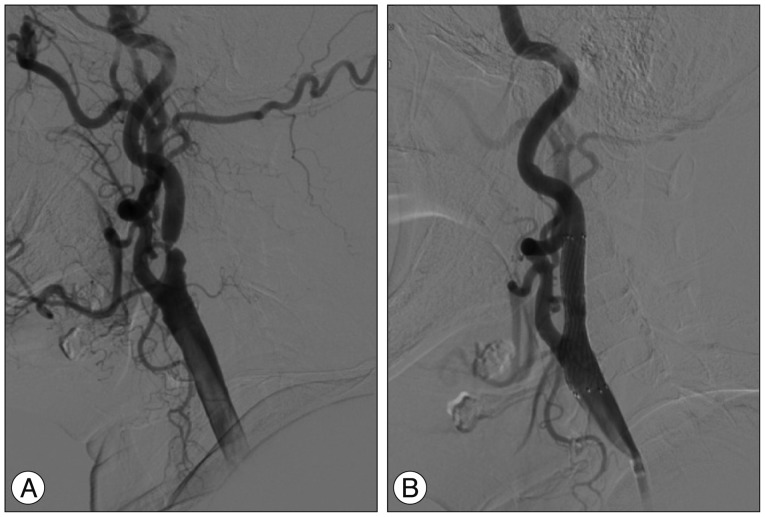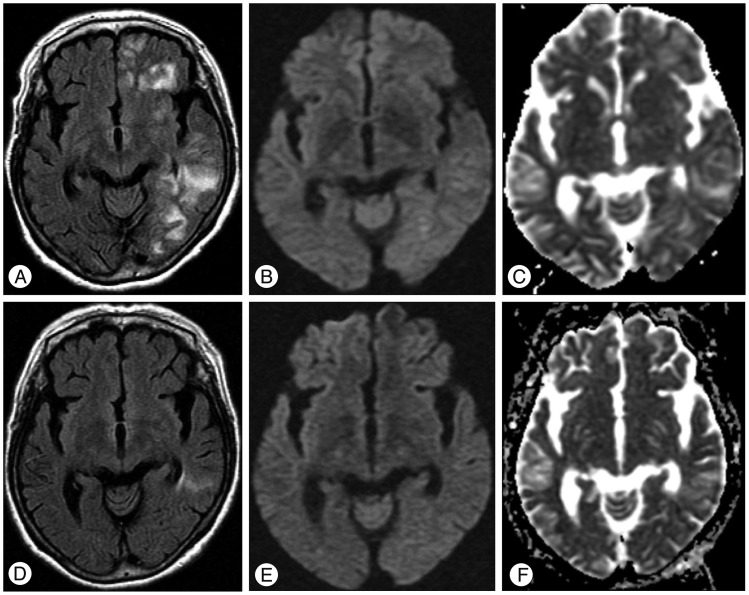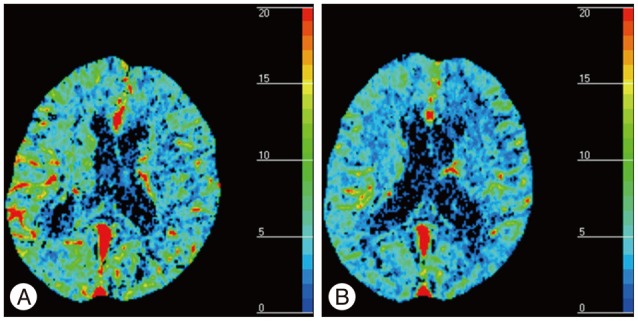J Korean Neurosurg Soc.
2014 Nov;56(5):441-443. 10.3340/jkns.2014.56.5.441.
Delayed Cerebral Hyperperfusion Syndrome Three Weeks after Carotid Artery Stenting Presenting as Status Epilepticus
- Affiliations
-
- 1Department of Neurology, College of Medicine, Hanyang University, Seoul, Korea. hyumcbrain@hanyang.ac.kr
- 2Department of Radiology, College of Medicine, Hanyang University, Seoul, Korea.
- KMID: 2018106
- DOI: http://doi.org/10.3340/jkns.2014.56.5.441
Abstract
- Cerebral hyperperfusion syndrome (CHS) is increasingly recognized as an uncommon, but serious, complication subsequent to carotid artery stenting (CAS) and carotid endarterectomy (CEA). The onset of CHS generally occurs within two weeks of CEA and CAS, and a delay in the onset of CHS of over one week after CAS is quite rare. We describe a patient who developed CHS three weeks after CAS with status epilepticus.
Keyword
Figure
Reference
-
1. Abou-Chebl A, Yadav JS, Reginelli JP, Bajzer C, Bhatt D, Krieger DW. Intracranial hemorrhage and hyperperfusion syndrome following carotid artery stenting : risk factors, prevention, and treatment. J Am Coll Cardiol. 2004; 43:1596–1601. PMID: 15120817.
Article2. Gelfand JM, Wintermark M, Josephson SA. Cerebral perfusion-CT patterns following seizure. Eur J Neurol. 2010; 17:594–601. PMID: 19968701.
Article3. Ho DS, Wang Y, Chui M, Ho SL, Cheung RT. Epileptic seizures attributed to cerebral hyperperfusion after percutaneous transluminal angioplasty and stenting of the internal carotid artery. Cerebrovasc Dis. 2000; 10:374–379. PMID: 10971023.
Article4. Kim DE, Choi SM, Yoon W, Kim BC. Hyperperfusion syndrome after carotid stent-supported angioplasty in patients with autonomic dysfunction. J Korean Neurosurg Soc. 2012; 52:476–479. PMID: 23323169.
Article5. Kuriyama Y, Hashimoto H, Nagatsuka K, Sawada T, Omae T. Effects of dihydropyridines on cerebral blood vessels. J Hypertens Suppl. 1993; 11:S9–S12. PMID: 8169383.
Article6. Lieb M, Shah U, Hines GL. Cerebral hyperperfusion syndrome after carotid intervention : a review. Cardiol Rev. 2012; 20:84–89. PMID: 22183061.7. McCabe DJ, Brown MM, Clifton A. Fatal cerebral reperfusion hemorrhage after carotid stenting. Stroke. 1999; 30:2483–2486. PMID: 10548688.
Article8. Moulakakis KG, Mylonas SN, Sfyroeras GS, Andrikopoulos V. Hyperperfusion syndrome after carotid revascularization. J Vasc Surg. 2009; 49:1060–1068. PMID: 19249185.
Article9. Ogasawara K, Sakai N, Kuroiwa T, Hosoda K, Iihara K, Toyoda K, et al. Intracranial hemorrhage associated with cerebral hyperperfusion syndrome following carotid endarterectomy and carotid artery stenting : retrospective review of 4494 patients. J Neurosurg. 2007; 107:1130–1136. PMID: 18077950.
Article10. Schoknecht K, Gabi S, Ifergane G, Friedman A, Shelef I. Detection of cerebral hyperperfusion syndrome after carotid endarterectomy with CT Perfusion. J Neuroimaging. 2012; [Epub ahead of print].
Article11. Sundt TM Jr, Sharbrough FW, Piepgras DG, Kearns TP, Messick JM Jr, O'Fallon WM. Correlation of cerebral blood flow and electroencephalographic changes during carotid endarterectomy : with results of surgery and hemodynamics of cerebral ischemia. Mayo Clin Proc. 1981; 56:533–543. PMID: 7266064.
- Full Text Links
- Actions
-
Cited
- CITED
-
- Close
- Share
- Similar articles
-
- Delayed Cerebral Hyperperfusion Syndrome after Carotid Artery Stenting: the Finding of Multimodal MRI
- Fatal Propofol Infusion Syndrome Associated with Refractory Partial Status Epilepticus in a Patient with Cerebral Hyperperfusion Syndrome
- Acetazolamide-Challenged Brain CT Perfusion before and after Carotid Stenting
- Acute Subdural Hematoma after Carotid Artery Stenting
- Contralateral Cortical Subarachnoid Hemorrhage as a Manifestation of Hyperperfusion Syndrome after Carotid Artery Stenting




